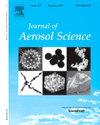Exposure to polluted environments rich in inhalable aerosols: A study on transport and deposition patterns of aerosol particles in the human respiratory tract
IF 3.9
3区 环境科学与生态学
Q2 ENGINEERING, CHEMICAL
引用次数: 0
Abstract
Exposure to air pollution environments rich in aerosol particles can cause serious damage to the human respiratory system. This study reconstructed a human respiratory tract model using medical CT scans. Six different respiratory patterns were obtained through ergonomic experiments. The study simulated and analyzed the transport and deposition patterns of dust under varying respiratory efforts and levels of environmental pollution. Experimental validation was conducted using a self-developed respiratory dust exposure system. The results indicate that inertial collision plays a significant role in the deposition mechanism as particles are transported through the human respiratory tract. The airflow forms a whirlpool at the throat, which contributes to dust deposition in this area. During exhalation, the airflow carries a large number of particles suspended in the respiratory tract from inhalation to be deposited in the upper respiratory tract. In the turbinate region, the concentration of dust is 74 % higher compared to inhalation. The curve representing the particle deposition rate with respiration effort can be approximated by the equation . As respiration effort increases, particles are transported deeper into more distal bronchi and show a greater tendency to deposit on the anterior walls of the airways. Notably, larger particles show higher sensitivity to changes in respiration velocity. When the respiration effort increases from 10 L/min to 85 L/min, the average deposition efficiency of particles changes from 18.67 % to 37.48 %. Among these, the escape rate of 1 μm particles remains consistently between 96.9 % and 98.4 %.
暴露于富含可吸入气溶胶的污染环境:气溶胶颗粒在人体呼吸道中的运输和沉积模式的研究
暴露在富含气溶胶颗粒的空气污染环境中会对人体呼吸系统造成严重损害。本研究利用医学CT扫描重建人体呼吸道模型。通过人体工效学实验获得了6种不同的呼吸模式。本研究模拟并分析了不同呼吸强度和环境污染水平下粉尘的迁移和沉积模式。采用自行研制的呼吸性粉尘暴露系统进行了实验验证。结果表明,惯性碰撞在粒子通过呼吸道传输的沉积机制中起着重要作用。气流在喉部形成漩涡,这有助于在该区域沉积灰尘。在呼气过程中,气流携带大量悬浮在呼吸道中的颗粒从吸入到上呼吸道沉积。在鼻甲区域,粉尘浓度比吸入高74%。颗粒沉积速率随呼吸功的曲线可近似为方程Y=A∙XB。随着呼吸力度的增加,颗粒被输送到更远的远端支气管,并更倾向于沉积在气道前壁。值得注意的是,较大的颗粒对呼吸速度的变化表现出更高的敏感性。当呼吸力从10 L/min增加到85 L/min时,颗粒的平均沉积效率从18.67%增加到37.48%。其中,1 μm颗粒的逃逸率稳定在96.9% ~ 98.4%之间。
本文章由计算机程序翻译,如有差异,请以英文原文为准。
求助全文
约1分钟内获得全文
求助全文
来源期刊

Journal of Aerosol Science
环境科学-工程:化工
CiteScore
8.80
自引率
8.90%
发文量
127
审稿时长
35 days
期刊介绍:
Founded in 1970, the Journal of Aerosol Science considers itself the prime vehicle for the publication of original work as well as reviews related to fundamental and applied aerosol research, as well as aerosol instrumentation. Its content is directed at scientists working in engineering disciplines, as well as physics, chemistry, and environmental sciences.
The editors welcome submissions of papers describing recent experimental, numerical, and theoretical research related to the following topics:
1. Fundamental Aerosol Science.
2. Applied Aerosol Science.
3. Instrumentation & Measurement Methods.
 求助内容:
求助内容: 应助结果提醒方式:
应助结果提醒方式:


